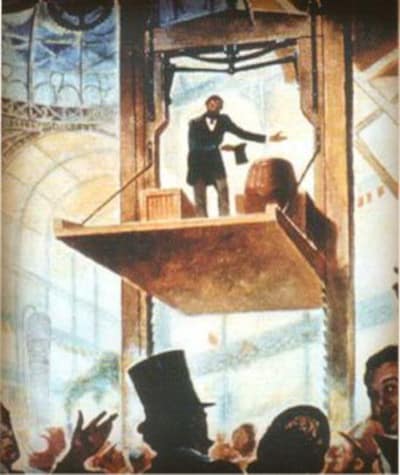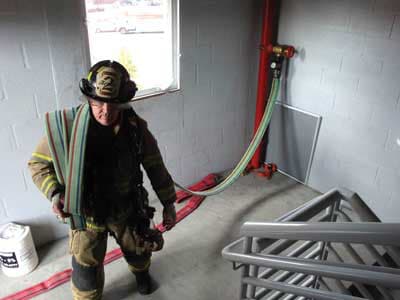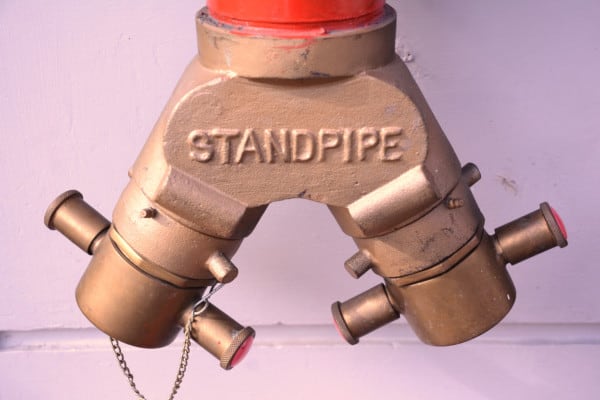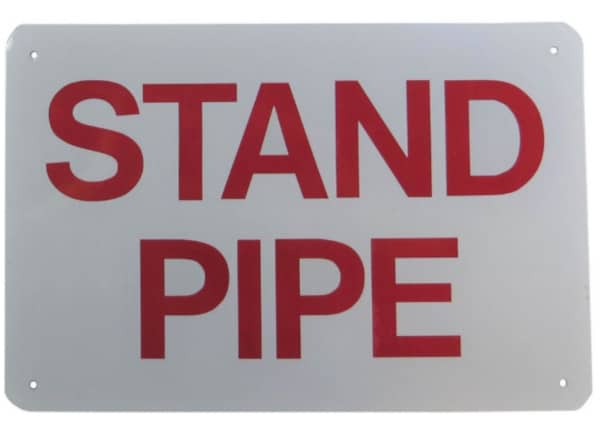A history of the invention, evolution, and function of standpipes
There are numerous safety innovations that have revolutionized the way we live, yet don’t merit a second (or first) thought from most people. One of these radical technological breakthroughs was invented by Elisha Graves Otis and introduced with great drama at the New York World’s Fair in 1854:
Perched on a hoisting platform high above the crowd at New York’s Crystal Palace, a pragmatic mechanic shocked the crowd when he dramatically cut the only rope suspending the platform on which he was standing. The platform dropped a few inches, but then came to a stop. His revolutionary new safety brake had worked, stopping the platform from crashing to the ground. “All safe, gentlemen!” the man proclaimed.
Otis had created the elevator brake, finally making elevators – which had been previously considered risky death traps – a practical, safe conveyance. The elevator industry was born, and with it came a revolution in architecture enabling taller and taller buildings, including the modern skyscraper. A simple innovation by an engineer from Halifax, Connecticut ushered in a new era of construction that created skylines around the world.

With the advent of the modern elevator and taller buildings came new safety challenges, however. Namely, how would firefighters combat fires on upper floors? Solving this problem led to the creation and decades-long evolution of fire suppression standpipes which were initially codified by the Committee on Standpipe and Hose Systems in 1914. This document was amended and adopted by the National Fire Protection Association (NFPA) in 1915, and formed the basis of what is now known as NFPA 14: Standard for the Installation of Standpipe and Hose Systems.
This article provides an overview of the different types and classes of standpipe systems, as well as explains when they are required according to NFPA 14, the International Fire Code, and the International Building Code.
Are you looking to buy accessories and equipment for your building’s standpipe system? If so, feel free to skip directly to our selection of fire department connections, and hose valves and accessories.
This post is part 1 of a 7-part series on standpipe systems:
- Fire Protection Standpipe System Overview and Introduction to NFPA 14
- Standpipe System Components and How to Maintain Them
- More Standpipe System Components and How to Maintain Them
- Acceptance Testing and Ongoing System Maintenance
- Maintenance Testing of Standpipes (Continued)
- Maintenance Testing for Automatic and Semiautomatic Dry Standpipes
- Standpipe Signs and Markings
What is a fire protection standpipe?
NFPA defines a standpipe as an “arrangement of piping, valves, hose connections, and associated equipment installed in a building or structure, with the hose connections located in such a manner that water can be discharged in streams or spray patterns through attached hose and nozzles, for the purpose of extinguishing a fire, thereby protecting a building or structure and its contents in addition to protecting the occupants.”
Simply put, standpipe systems are a network of piping in a building fed by a water supply and featuring numerous outlets for the water. They are essentially indoor fire hydrants that allow occupants, firefighters, or both to access water to fight fires. And just like the elevator brake, they have made the construction and safe use of tall buildings possible.

Classes of standpipe systems
Standpipes are divided into five types that fall under three classifications, the latter of which govern who can access water during a fire.
Class I standpipe systems feature 2.5” hose connections that can only be accessed by firefighters during an emergency. Their outlets are usually located within the stairwells of buildings (in addition to other areas) and they are restricted to use by professional firefighters because the system’s high water pressure makes controlling the hose difficult. As a result, firefighters must bring a hose to the site that specifically attaches to these connections.
Note: While the vast majority of locales use 2.5” hose connections, New York and San Francisco are the only areas commonly using a special 3” connection.
Class II standpipe systems feature permanently-installed hoses on pin racks or reels that can be accessed by anyone in the event of a fire. They feature 1.5” hose connections and are often located in hallways of buildings. Because hoses are sometimes poorly maintained and building owners are concerned about liability if an untrained individual gets hurt trying to fight a fire, these systems have fallen out of favor and are typically present in older buildings.
Class III standpipe systems are a hybrid of Class I and Class II systems, featuring both 2.5” and 1.5” hose connections with permanently available hoses attached to the 1.5” connections. The first Class III systems had a 2.5” connection with a reducer that allowed an installed hose to be attached to a 1.5” connection; firefighters remove the reducer to attach larger hoses. Some later versions feature both a 2.5” firefighter connection in addition to a separate 1.5” connection attached to an onsite, installed hose. Finally, there are versions of Class III systems that feature a 2.5” connection, a reducer to a 1.5” connection, and no installed hose.

Types of standpipe systems
In addition to Standpipe’s three classes, there are five types of standpipe systems that reflect how the water is delivered to outlets:
Automatic wet standpipe systems have pressurized water in their pipes at all times. When a hose outlet is opened, water immediately flows from them, hence the word “automatic.” The practical impact is that these systems do not require firefighters to supply water and pressure to the system to make them work. Automatic wet standpipes are not suited for environments where low temperatures will cause water to freeze and damage the pipes. They are commonly used in high rise buildings where it would be impractical for the fire department to pump enough water at a high enough pressure to deliver water to high floors.
Automatic dry standpipe systems: Just as with the wet variety, these systems also supply water on demand when a valve is opened, as they are permanently connected to a water supply. Instead of having pressurized water in the system at all times, however, they are filled with pressurized air. When the valve is opened, it releases the pressurized air which trips a differential dry-pipe valve, causing water to flood into the system. These systems usually require a permanent, onsite fire pump to deliver enough pressure, and they are better suited for freezing environments as well as high-rise parking garages.
Semiautomatic dry standpipe systems have mildly pressurized air in most of the piping that runs from a deluge (preaction) valve to the hose outlets, but have water in the lesser piping between the water supply and the deluge valve. To activate the system, firefighters connect hoses and send a signal to an alarm panel, which activates the deluge valve and enables water to flood the entire system. Like automatic dry systems, these semiautomatic dry standpipes typically require an onsite fire pump and are well-suited for buildings where the majority of the piping is subject to freezing temperatures.
Manual wet standpipe systems are similar to automatic wet systems in that water sits in the pipes at all times. The water is not pressurized to fight fires by simply opening a valve, however. To achieve enough pressure, the fire department must arrive and use a pumper to push an external water supply into the system through the building’s fire department connection (FDC). These systems are typically less expensive than other systems but are only suited for heated buildings where water is not going to freeze. An advantage of having water in the pipes at all times is that obvious leaks are easier to spot before an emergency.
Manual dry standpipe systems are essentially a system composed of empty pipe. Neither water nor pressurized air fills the pipe, which requires the fire department to arrive and supply both through the FDC. These systems are obviously less expensive and work in freezing environments, but the lack of water or pressurized air in the pipes makes it harder to spot any leaks that may accrue due to corrosion or other damage. These systems are considered much less reliable than other types because it’s hard to spot these flaws, and they have become much less common as a result.

What structures require a standpipe system?
The requirements for installing standpipe systems are found in NFPA 14, which in turn informs the regulations in the International Fire Code (IFC) and the corresponding International Building Code (IBC). The IBC, in turn, guides the majority of the adopted building codes for states and cities in the US, though current local codes can lag behind the latest edition of the IBC. Section 905.3 of the IBC covers “required installations.” The most common and all-encompassing qualification for whether a standpipe system is necessary is a building’s height or depth:
From the 2015 Edition of the IBC
905.3.1 Height
Class III standpipe systems shall be installed throughout buildings where the floor level of the highest story is located more than 30 feet (9144 mm) above the lowest level of fire department vehicle access, or where the floor level of the lowest story is located more than 30 feet (9144 mm) below the highest level of fire department vehicle access.
Essentially, this covers both tall buildings and basements. If a floor of the highest story is more than 30 feet above the highest point a fire apparatus can reach – which would force hose to be run a very long distance – you need a standpipe. The same goes for deep basements that would require a great length of hose from a fire apparatus.
The IBC also requires standpipes in the following:
- Class I automatic wet standpipes are required for non-sprinklered Group A buildings having an occupant load exceeding 1,000 persons. Group A Buildings are those that are used for assembly.
- Covered and open mall buildings.
- Structures with stages greater than 1,000 square feet in area (93 m2) shall be equipped with a Class III wet standpipe system with 1.5” and 2.5” hose connections on each side of the stage.
- Underground buildings must “be equipped throughout with a Class I automatic wet or manual wet standpipe system.”
- Buildings with a rooftop helistop or heliport shall be equipped with a Class I or III standpipe system extended to the roof level.
- Marinas and boatyards must have standpipe systems in accordance with NFPA 303: Fire Protection Standard for Marinas and Boatyards.
- Buildings or structures that have rooftop gardens or landscaped roofs and that are equipped with a standpipe system shall have the standpipe system extended to the roof level on which the rooftop garden or landscaped roof is located.
Your online destination for standpipe system components is QRFS.com
This concludes part one of our review of standpipe systems and their applications. In part two of this series, we will take a look at the components of different standpipe systems and the required maintenance and inspection of each, as well as the common issues faced by building owners who are attempting to keep these systems working and compliant with code.
If you’re looking to buy components for your standpipe system, QRFS offers a range of pin rack units, fire hose reels, standpipe cabinets, hose valves, FDCs, signs and more.
Get Standpipe System Components Here
If you have any questions about standpipes or need help finding an item, give us a call at 888.361.6662 or email us at support@qrfs.com.
Check out the other posts in our series on standpipe systems:
- Fire Protection Standpipe System Overview and Introduction to NFPA 14
- Standpipe System Components and How to Maintain Them
- More Standpipe System Components and How to Maintain Them
- Acceptance Testing and Ongoing System Maintenance
- Maintenance Testing of Standpipes (Continued)
- Maintenance Testing for Automatic and Semiautomatic Dry Standpipes
- Standpipe Signs and Markings




what do you mean by Class I, II, and II? what do they represent?
also Group A,…?
Nadim — The descriptions of standpipe classes are in the article, but essentially, Class I are firefighter use/hose connections only, Class II have occupant-use hoses, and Class III can have both hose connections for firefighters and occupant-use hoses. “Groups” refer to building classifications in International Code Council (ICC) codes, in this case, the International Building Code. Group A, for example, refers to “Assembly” occupancies where a lot of people usually gather.
QRFS team,
Is it possible to comply for a wet stand pipe to an existing 3 storey building with a FA of 150 sqm more or less? What are the grounds of having stand pipes?
Thank you for your time…
Beth — Here is a good rundown by NFPA of where standpipes are usually required.For more specific assessments of standards, codes, and systems in specific settings, you can try our Ask a Fire Pro service. Click the link to submit your question with some information about your building and system, and a fire protection professional will provide an answer based on best practices, standards, and codes. Our pros include AHJs, contractors, engineers, and code experts with 150+ years of combined experience!
Wet sprinkler system has the FDC on the fire protection backflow preventer.The building also has a FDC for the manual dry standpipe system but they tied the wet system in to the dry manual standpipe system by adding a check value along with mechanical tee’s.so if fire department puts water on the dry standpipe they will also be applying water & pressure to wet sprinkler system.is this legal??? I thought no other system could be attached to the manual dry standpipe?? Thank you for your time
Mark — For code and system application questions like this, you can try our Ask a Fire Pro service. Click the link to submit your question with some information about your building, and a fire protection professional will provide an answer based on best practices, standards, and codes. Our pros include AHJs, contractors, engineers, and code experts with 150+ years of combined experience!
I have always used chapter 9 in the IBC and IFC to determine when and where standpipes are required and NFPA 14 as the standard on how to install standpipes. I know a fire marshal that believes NFPA 14 chapter 5 section 5.1 can be used to override the requirements in chapter 9 to get standpipes installed in structures that don’t require them per chapter 9. Is this the correct interpretation?
Rick — For code interpretation questions like this, you can try our Ask a Fire Pro service. This question would be the lower price tier. Click the link to submit your question with some information about your building, and a fire protection professional will provide an answer based on best practices, standards, and codes. Our pros include AHJs, contractors, engineers, and code experts with 150+ years of combined experience!
How do you test a standpipe system in an older building where the water supply for the standpipe system is fed from the domestic water supply for residential units. If the standpipe system was pressurized, the plumbing fixtures would blow off the walls!! This is an older building built in the late 60s. There is a 4 inch line coming into the building that serves both the standpipe and domestic water. A little bit of a issue since the Fire Department wants mandatory testing done every 5 years No idea how to pressurize unless the system is revamped??
Bill — For system, standards, and code questions like this, you can try our Ask a Fire Pro service. Click the link to submit your question with some information about your building and system, and a fire protection professional will provide an answer based on best practices, standards, and codes. Our pros include AHJs, contractors, engineers, and code experts with 150+ years of combined experience!